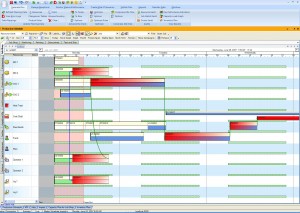 Heads-up: this article will have more questions than answers. But I do think it will be a good platform for thinking about working solutions to difficult questions. The main question considered here is “What options are there for handling uncertainty in schedules?”
Heads-up: this article will have more questions than answers. But I do think it will be a good platform for thinking about working solutions to difficult questions. The main question considered here is “What options are there for handling uncertainty in schedules?”
One line of thought focuses on the idea of buffering time, resources, and/or inventory in the schedule. These buffers are added on top of the time standards and lead times on items. It seems that there is widespread agreement that creating a schedule—that is, promising delivery dates to your customers - without allowing for some extra time in the schedule will lead to some disappointed customers. Interestingly, not factoring in variation on time estimates also increases the variation on delivery dates for other work in the schedule as adjustments are made to the rest of the work in the plan.
Some opportunity exists for being more scientific about setting the size of any buffers. Using data distributions and statistical tools, it might be possible to determine what the “correct” buffers should be for a given process. This approach, however, faces the obstacles of collecting this data and verifying its usability in your environment. Whenever buffers sizes are assessed, a more vital question might be: “What financial impact do buffers have on our company?” It would also be worthwhile to explore the underlying assumptions behind the buffers that are already in place.
A second line of thought for reducing uncertainty might show some promise. In this case, focus can be placed on controlling how early work on a job can begin. This is also known as controlling the release dates for when work is made available to the manufacturing floor. Run times and setup time standards will certainly vary from whatever their specified values are, but variation can also be introduced by having too much open work on the floor. Most of us know this as work in process inventory or WIP. More WIP often means longer lead times to customers and difficulty in prioritizing and tracking down current progress on jobs.
Reducing WIP generally means a smoother flow for all work. Think about this situation: if the CEO asked that a product be made right now and carried through the whole process, most likely that would take a lot less time than the average lead times the current schedule is providing. That higher velocity flow can be achieved by delaying the start of work, allowing production steps to move more quickly from one to the next.
Delaying release of work to the shop floor also seems like a viable idea, but there is risk in waiting too long and missing due-dates. There is also the question of when to order materials to begin the job—although manufacturing might be able to wait to begin work, most companies will not want to take a high risk that their vendors won’t be able to supply the needed materials in a just-in-time environment.
I don’t see an easy answer to the question I started with. It does seem worthwhile to start to quantify aspects that affect these decisions:
- How much WIP is on the floor on average? Has this been increasing or decreasing?
- How reliable are the delivery dates quoted to customers?
- What expenses are incurred in scrambling to meet due-dates when variations hit the schedule?
With this information, a number of potential answers can be explored and the approach that produces the best results can be applied.




















LEAVE A COMMENT